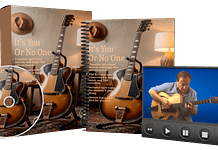This post may contain affiliate links. As an Amazon associate, Google associate as well as associate for other programs, Guitar & Music Institute may earn commissions from qualifying purchases.

If you’re venturing into the rich world of jazz guitar or seeking to refine your jazz stylings, mastering an array of songs from the jazz repertoire is a quintessential step. To truly absorb the artform, a curated jazz standards list offers more than just tunes for your performance lineup. Such a list becomes a treasure trove of knowledge, allowing you to deeply explore and understand the sophisticated melodic lines, intricate harmonic frameworks, and the signature rhythmic pulses that give jazz music its distinctive allure.
Whether you’re a newcomer to the genre or an already swinging player, adding popular jazz songs to your set enables you to navigate the common language among jazz aficionados. Meanwhile, for the aspiring musician, easy jazz standards provide the perfect pitch to commence your journey, familiarizing you with the foundational elements that sculpt the genre’s dazzling soundscape. So, prioritize your learning experience and learn jazz standards to infuse your playing with the authentic spirit of jazz.
The Importance of Learning Jazz Standards
If you’re aspiring to make your mark in the jazz world, understanding and being able to play jazz standards is non-negotiable. Think of these tunes as the essential vocabulary of a language; without them, you’d be hard-pressed to communicate effectively in a musical conversation. Jazz standards for beginners are the building blocks for your future fluency in the genre, enabling you to join jam sessions and converse musically with peers globally.
Much like learning a new dialect, each city and community may have its unique spin on the jazz repertoire. Yet, there are certain beginner jazz songs that resonate universally, making them indispensable in your learning journey. Mastery of these pieces can elevate your gig performances to new heights and pave the way for more sophisticated improvisational ventures.
- Improves harmonic comprehension
- Enhances improvisational abilities
- Facilitates musical connectivity at a global scale
- Provides a sense of belonging within the jazz community
Embarking on this musical voyage is not just about learning a series of notes and chords; it’s about immersing yourself in the rich history and culture of jazz music. The standards you learn will not only become a part of your technical toolkit but also a means to express your creative voice. As a beginner, embrace these songs, for they are the gateway to your continued growth and participation in the ever-evolving narrative of jazz.
Unveiling the Jazz Language Through 15 Jazz Standards For A Beginner Repertoire
Embarking on your journey to learn jazz, you’ll soon discover that jazz is not just music, it’s a language of its own. This language is built on classic jazz standards, the timeless anthems that form the cornerstone of jazz repertoire worldwide. Diving into these pieces, you not only study music but also join a conversation that has been ongoing for decades among jazz aficionados and musicians alike.
Understanding Jazz Phrasing and Slang
Like any language, jazz has its own set of phrases and slang, fundamental for soloing and comping. By exploring tunes known for being some of the best jazz standards, you internalize these musical expressions. This knowledge enables you to improvise with the fluency of a seasoned player, even during your initial learning phases.
Regional Variations in Jazz Repertoire
Noticing the nuances between regions reveals the diverse character jazz possesses. While certain tunes like “Autumn Leaves” and “Take the ‘A’ Train” are ubiquitous, others may be favored more in New Orleans, New York, or Paris. However, the shared understanding of core standards connects jazz communities worldwide.
The Snowball Effect in Jazz Learning
As you accumulate knowledge of the great jazz standards, you’ll experience a snowball effect in your learning. Each new piece you master exponentially broadens your musical lexicon, making it easier to grasp additional songs and jazz idioms. Over time, the initially daunting list transforms into a personal repertoire reflective of your musical journey.
Developing Your Improvisation Skills with Jazz Standards
Embarking on the path to learn jazz standards is not solely about memorizing melodies and harmonies—it’s about delving deep into the art of improvisation. This journey can transform your musical expression, providing you a canvas to paint your unique sound on a mosaic of timeless tunes.
Mastering Chord Changes and Progressions
Understanding the intricacies of chord changes and progressions is fundamental when it comes to jazz. These are the building blocks that allow you to fluently navigate the landscape of a song. As you immerse yourself in jazz standards, you begin to anticipate the flow of the music, leading to more confident and imaginative improvisations. Strengthening this skill is a continuous process, where each standard you master adds another layer to your musical prowess.
Connecting with Jazz Musicians Over Common Tunes
When you learn jazz standards, you’re doing more than expanding your repertoire—you’re opening up channels for communication with fellow musicians. These common tunes serve as a shared language, allowing you to seamlessly join jam sessions and musical collaborations. Whether it’s at a bustling jazz club or an intimate gathering of enthusiasts, knowing these standards creates an instant bond with others in the jazz community, reaffirming the saying that music is indeed the universal language.
The process of learning jazz standards paves the way for profound musical development. It’s not just about the notes you play, but how you interpret and deliver them, turning each performance into a heartfelt conversation. Your growth as a jazz musician is marked by the standards you absorb; each tune you learn is an anecdote in your musical narrative, a story waiting to be told through your instrument.
Easy Jazz Standards to Jumpstart Your Jazz Journey
Embarking on your jazz odyssey is an exciting endeavor, and you need not be daunted by the complexity often associated with jazz. Gravitating towards easy jazz standards can provide a welcoming introduction to this rich musical genre. To ease into the rhythmic sway and harmonic allure of jazz, we’ve selected a range of beginner jazz songs that stand out for their simplicity and heritage. These pieces serve as an ideal starting line from which you can accelerate your journey into deeper and more intricate jazz territories.

By learning these beginner-friendly tunes, you establish a foundation that will sustain your future growth as a jazz musician. The chord progressions and melodic structures you’ll encounter act as the building blocks of more advanced compositions. Here are songs that are not just easy to learn, but also vital for any aspiring jazz artist’s vocabulary:
- “Autumn Leaves” – With its iconic melody and harmonic sequence, it’s the quintessential standard for new jazz enthusiasts.
- “Summertime” – This Gershwin classic will help you understand modal jazz and the beauty of simple, emotional expression.
- “Blue Bossa” – A blend of bossa nova rhythm and blues, it’s a perfect fusion of style and simplicity.
- “So What” – With its modal approach, this tune introduces you to a different side of jazz that encourages individuality in improvisation.
- “Take the A Train” – Capture the essence of swing with this Duke Ellington standard that is both memorable and straightforward.
- “All The Things You Are” – A must know song that many players see as a right of passage with it’s many key changes.
- “Satin Doll” – A Duke Ellington classic that is the mainstay of cocktail bars around the world.
- “Perdido”- A great swinger for the 40s that has a great melody and a chord progression that is wide open for soloing.
- “Wave” – A Jobim bossa nova classic that is without doubt a challenge from a soloing perspective for the beginner.
- “Mr PC” – Song from the seminal jazz album “Giant Steps” by John Coltrane which is usually played at faster tempos.
- “Blue Monk” – Blues work by Thelonious Monk based on a simple blues progression with the solos played over an expanded chord pallet.
- “The Girl From Ipanema” – Another legendary song by Antônio Carlos Jobim which is one of the most requested songs out there.
- “Watermelon Man” – A funky piece by Herbie Hancock which should be in every aspiring jazz players repertoire.
- “On Green Dolphin Street” – The song from a film, based on a book of the same name. This song has several keys to navigate and styles.
- “Fly Me To The Moon” – One of the most famous songs sung by Frank Sinatra. An absolute must know in any jazz players locker.
By embracing these accessible pieces, you’ll not only develop a firm grasp of basic jazz idioms but also gain confidence in your playing. Remember, the key to mastering these standards lies in consistent practice and active listening. Dive into these tunes with curiosity and patience, and watch as your jazz fluency blossoms.
Jazz Sheet Music and Learning Tools
Improving your prowess in the realm of jazz begins with access to the right jazz sheet music and educational tools. These resources, rich with melodies and chord symbols, provide an essential framework for learning and internalizing jazz standards. Beyond the notes and progressions, having rhythm guidelines at your fingertips empowers your practice sessions, allowing you to capture the true essence of swing and syncopation inherent in jazz music.
For those who seek a deeper understanding and are ready to commit to mastering this genre, specialized communities offer monthly programs designed to dissect and analyze jazz standards. The Inner Circle, for example, is one such platform where courses are meticulously crafted to refine your technique and expand your jazz vocabulary.
With the right tools, jazz is not just music you play; it becomes a language you speak fluently, letting you express your deepest emotions through your instrument.
Consider the following curated list of essential jazz sheet music and learning aids that can prodigiously enhance your musical journey:
- An array of beginner to advanced jazz sheet arrangements
- Rhythmic exercises to help internalize the swing pattern
- Interactive platforms for play-along and improvisation practice
- Video tutorials by experienced jazz musicians
- Community forums for peer-to-peer feedback and discussions
Ingrain the intricacies of jazz by diving into its musical notation; the investment in quality jazz sheet music will pay off when you find yourself improvising with confidence at your next gig or jam session.
Exploring Sub-Genres of Jazz Through Standards
Delving into the jazz standards list is akin to embarking on a thrilling journey through time and culture. With each riff and melody, you tap into the rich diversity of sub-genres of jazz, each harboring its own rhythms and historical context. As you familiarize yourself with standards from each sub-genre, your understanding of jazz’s complexity deepens exponentially.

Cutting your musical teeth on bebop standards, you’ll navigate the intricate melodies and harmonic challenges that marked an era of jazz evolution. Engaging with swing tunes, you’ll feel the pulse that once made ballrooms buzz with energy. Bossa nova’s soft, lilting beat will transport you to the breezy beaches of Brazil, while the deep grooves of funk fill your soul with their syncopated rhythms. In Latin jazz, you’ll discover a world where intricate Afro-Cuban patterns collide with jazz harmonies to create a pulsating soundscape.
Beyond just expanding your repertoire, these standards are your gateway to understanding the vast narrative of jazz. Here’s a glimpse into the variety:
- Bebop — Dizzy Gillespie’s “A Night in Tunisia”
- Swing — Duke Ellington’s “Take the ‘A’ Train”
- Bossa Nova — Antonio Carlos Jobim’s “The Girl from Ipanema”
- Funk — Herbie Hancock’s “Chameleon”
- Latin Jazz — Tito Puente’s “Oye Como Va”
Exploring these standards, you’ll recognize recurring themes and progressions – a testament to jazz’s interwoven history. Studying these tunes not only diversifies your skills but also serves as a profound connection to the musicians who composed and played them, a dialogue across generations.
Whether you’re a seasoned musician or a budding enthusiast, a deep dive into jazz’s eclectic sub-genres will reward you with not just musical knowledge, but a profound appreciation for this art form’s rich history and enduring vitality.
The Role of Jazz Standards in Jam Sessions and Gigs
As you step into the vibrant world of jazz, popular jazz songs become more than just melodies; they transform into a universal code, a pathway to the heart of musical communion. Approach any jam session or live gig, and you’ll notice the foundational role played by jazz standards for beginners. These tunes serve as the common ground for musicians of varied expertise to embark on a collaborative journey of improvisation and exploration.
Imagine a group of talented artists, each armed with their instruments, ready to converse in the language of music. You can witness the pure magic of collective sound where individual creativity shines all thanks to the shared knowledge of jazz standards. They function as both the stepping stones for those new to jam sessions and the battleground for seasoned musicians to flaunt their adroitness.
But what does it take to navigate such sessions with ease?
- Deep familiarity with jazz standards welcoming beginners and aficionados alike,
- Confidence in your improvisation abilities, fostered by these timeless pieces,
- Devotion to practicing and perfecting the art of jazz expression through song.
The more you immerse yourself in these classics, the more adept you become at interpreting the ebb and flow of this genre. Your participation in such sessions becomes more than just performance; it evolves into an artful dialogue with fellow musicians, giving rise to a mesmerizing spectrum of sound that can only be described as the essence of jazz.
Embrace the popular jazz songs known at gigs worldwide, and find your place within the exciting, improvisational tapestry that is a live jazz performance.
Essential Recordings of Jazz Standards to Listen To
Delving into the world of classic jazz standards, it’s not merely about the notes you play, but the legacy you tap into. The very best jazz standards come to life through their timeless recordings, captured by the greats who’ve defined what jazz is today. As you broaden your musical horizons, consider these essential recordings not just as listening material, but as the cornerstones of your jazz education.

Influential Performances of “All of Me”
Imagine the soulful voice of Louis Armstrong weaving through the timeless melody of “All of Me,” an undisputed gem in the treasury of jazz. Armstrong’s rendition is not just a performance; it’s a masterclass in the art of jazz interpretation and expression that sets the bar for vocalists and instrumentalists alike.
Evolution of “Autumn Leaves” Through the Years
From the vibrant tapestry of jazz history, “Autumn Leaves” emerges as a profound narrative told differently by each artist. The reflective depth of Bill Evans’ piano interpretations juxtaposes the spirited saxophone lines of Cannonball Adderley, showcasing how one standard can traverse emotional landscapes.
Significance of “Blue Bossa” in Latin Jazz
When Joe Henderson first introduced “Blue Bossa,” it wasn’t merely a song—he presented a portal into the nuanced world of Latin jazz. The syncopated rhythms and the melodic flair of this tune pose an irresistible challenge to enthusiasts, eager to decode its rhythmic and harmonic intricacies.
Acknowledge these recordings as foundational—your stepping stones to understanding the best jazz standards that have raised generations of musicians. Listen, learn, and let the history of jazz guide your own musical journey.
Navigating Chord Progressions: A Guide for Beginners
As you embark on your journey to learn jazz standards, understanding chord progressions is like being handed the keys to a treasure trove of musical possibilities. Jazz standards for beginners can often seem intricate, but with this guide, you’ll realize how approachable they truly are when you break down the harmony into manageable parts. In particular, the jazz sheet music for these timeless tunes often highlights common chord sequences that are essential for every budding jazz musician.
Major and minor ii-V-I progressions are the backbone of many jazz standards; they are the equivalent of learning your ABCs before you form sentences. Embrace these harmonic progressions and you will find improvising over them becomes second nature, allowing your creativity to flourish.
- Begin with ii-V-I: Start by practicing the ii-V-I progression in both major and minor keys. This foundation will recur in countless jazz standards.
- Learn Voice Leading: Understand how to move smoothly between chords. Voice leading is not just for singers – it’s a principle that guides the transitions between chords, ensuring a seamless harmonic flow.
- Explore Improvisation: Once comfortable, try improvising over these changes. No need to be complex; sometimes a simple melody sings the sweetest.
With mastery over these elements, jazz sheet music becomes not just notes and chords on a page, but a map for your musical expression. As your skills advance, explore more complex progressions and observe how your favorite jazz musicians navigate through the changes.
Remember, learning jazz is not just about practice – it’s about playing. The best way to internalize these progressions is to immerse yourself in the music. Play with others, listen to the greats, and always keep swinging!
Classic Jazz Standards vs. Modern Jazz Compositions
As you delve into the captivating realm of jazz, you’ll find yourself at a crossroads between the storied classics that have shaped the genre and the forward-looking modern compositions that continue to redefine it. Classic jazz standards serve as the cornerstone for your understanding, providing a framework that has seasoned the musical environment for ages. By contrast, modern jazz pieces dare to experiment, challenging the boundaries of jazz with their inventive chords and rhythms. Both schools of thought contribute indispensably to the rich tapestry of jazz music and offer pivotal learning moments for any aspiring musician.
The Enduring Appeal of Classic Jazz Tunes
Immersing yourself in classic jazz tunes is akin to conversing with the legends of jazz; it’s where you learn jazz standards that have been time-tested and widely revered. Numbers like “Summertime” and “Mack the Knife” exemplify the quintessence of jazz’s golden era, each tune echoing the creativity and soul that gave rise to the genre. These staples, rife with emotional depth and complexity, serve as essential touchstones for not only your technical skillset but also for your interpretative insight. The resilience of these melodies underscores their role in training and inspiring generations of jazz enthusiasts.
Embracing Contemporary Jazz Pieces in Your Repertoire
Meanwhile, wading into the waters of modern jazz will expose you to the avant-garde, the cutting-edge sounds that continue to evolve and expand jazz’s horizons. Embracing these contemporary jazz pieces is fundamental for a well-rounded skill set, as they impel you to engage with more sophisticated harmonies and structural intricacies. Modern jazz, with compositions from artists like Wayne Shorter and Robert Glasper, stands as a testament to jazz’s unceasing innovation. These fresh pieces offer a different kind of educational value, one that encourages you to grow and evolve alongside the changing landscape of jazz music.
Source Links
- https://www.learnjazzstandards.com/blog/50-jazz-standards-you-need-to-know/
- https://www.learnjazzstandards.com/blog/20-easy-jazz-standards/
- https://tamingthesaxophone.com/theory/impro/jazz-repertoire
This post may contain affiliate links. As an Amazon associate, Google associate as well as associate for other programs, Guitar & Music Institute may earn commissions from qualifying purchases.



















